Insider Advice 7 Meal Times in Spain
This is more than a guide – it’s a survival guide for meal times in Spain.
For a casual reader, this might be an outrageous claim. But trust me – I was hungry because I didn’t know about it.
You’re about to discover the secrets of Spanish meal habits and meal times in Spain.
This article is based on my 15+ years of experience as an expat in Spain.

Apart from living here immersed in Spanish culture, I researched Spanish nutritional habits between 2013 and 2015.
This survey for the research had 37 questions regarding nutrition and lifestyle. I got responses from 332 adults between 18 and 61 years. I used these insights in this guide.
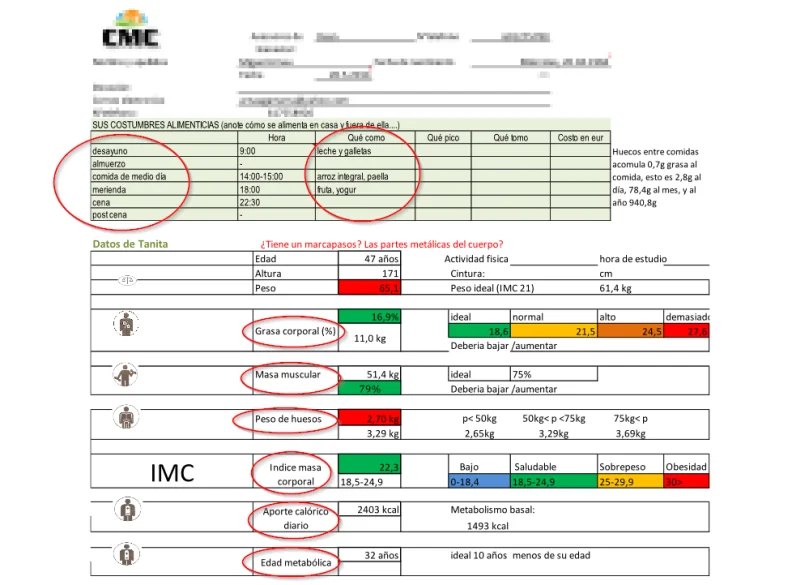
Now that you know the background of this guide, let’s dive into our topic.
Here are the meals we’ll explore:
Breakfast #1
Breakfast # 2
Lunch
Afternoon snack
Evening appetizer
Dinner
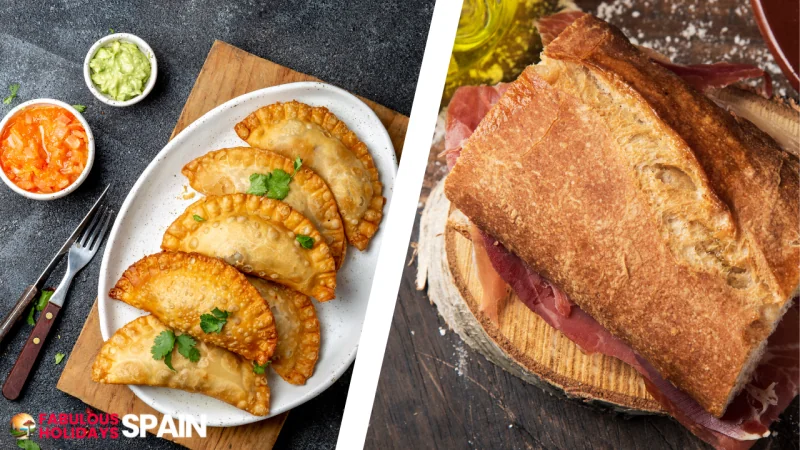
Here is, in a nutshell, what and when people in Spain eat.
Breakfast #1 (Desaynuo)
Meal time: 7 – 9 AM
What they eat: Bread, coffee, milk, orange juice, biscuits.
Breakfast #1 (Almuerzo)
Meal time: 10 – 11 AM
What they eat: Sandwich, tea, coffee.
Lunch (Comida de Mediodía)
Meal time: 2 – 3:30 PM
What they eat: Meat, lentils, pasta, potato, rice, salad, paella, soup, vegetables.
Afternoon Snack (Merienda)
Meal time: 5 – 8 PM
What they eat: Fruit, sandwiches, bread, jamon, yoghurt, fruit.
Dinner (La Cena)
Meal time: 8 PM – 11 PM
What they eat: Fish, potato, meat, salad, sandwich.
Night Snack (Post Cena)
Meal time: 11 PM – 12 PM
What they eat: Milk, pastries, tea.
Depending on the lifestyle 24% of people skip morning or evening snacks.
Source: Personal research data
Skipping meals is more common among younger people and those living in urban areas.
The biggest reasons listed why people might skip merienda or almuerzo are:
- Lack of time: Many people are busy with work or school and don’t have time to eat a proper meal.
- Cost: Eating out for merienda or almuerzo can be expensive.
- Dietary restrictions: Some people have dietary restrictions that make it difficult to find suitable merienda or almuerzo options.
Related: After eating out, how to ask the bill in Spanish restaurant or other establishment?
In the continuation, we will explore meal times in Spain in more detail.
We’ll discover that mealtimes are central to Spanish culture and that socializing is more important than meals.
Meals are not just about fueling bodies; they’re about connecting with family and friends and embracing the rhythm of life.
Spain is where living a good life is the most important affair.
Seriously. Quality time with friends, family, and colleagues is a priority in Spain.
So, grab your appetites and let’s dive into the world of Spanish mealtimes!
On average, each Spaniard consumed an intake of 583.48 kilos in 2022 within the home.
Source
We’ll start with breakfast #1 (desayuno), the first meal of the day, and move on to breakfast #2 (almuerzo).
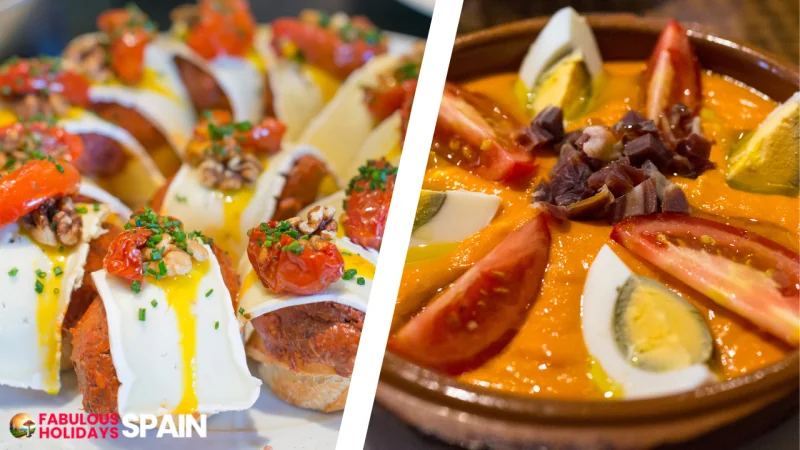
Then, we will discuss lunch (la comida de mediodia), an afternoon snack (merienda), an evening appetizer (tapas), and dinner (cena).
We’ll uncover the regional variations that make Spanish cuisine diverse and interesting along the way.
Get ready to taste the flavours of Spain and experience the joy of sharing a meal with others.
Vamos a comer!
Breakfast # 1 (Desayuno) Meal Times in Spain
When: Between 7 AM and 9 AM.
Where: Usually at home
The surprising habit in Spain is to eat 2 breakfasts.
One could argue the second one is a morning snack and would be right. But keeping in mind that people often skip breakfast #1 it is fair to name it breakfast #2.
Spaniards never skip breakfast No. 2 (almuerzo) so it does serve as a breakfast.
The first breakfast is usually at home, and the second, more substantial one, is at a workplace or school.
In Spain, many people skip breakfast #1 and grab a quick coffee or warm chocolate milk before heading for work.
If they eat something more than a coffee, it would be some carb-based meal.
Some typical Spanish breakfast foods for the first meal of the day include:
- Croissants, whether plain, filled with chocolate, cream, or jam
- Baked sweet yummies such as cookies or muffins
- A bowl of milk, Colacao and cereal
- Orange juice or milk
They drink coffee drinks (café con leche, americano, cortado) or a glass of fresh orange juice with these meals.
Let me translate these for you so you can have them handy when ordering one.
- Cafe con leche is milk with coffee
- Americano is a big black coffee
- Cortado is a short shot of black coffee.
The real breakfast will be after they arrive at the workplace, school or another destination.
Breakfast # 2 (Almuerzo) Meal Times in Spain
When: Between 10 AM and 11 AM.
Where: At home, tapas bar, park.
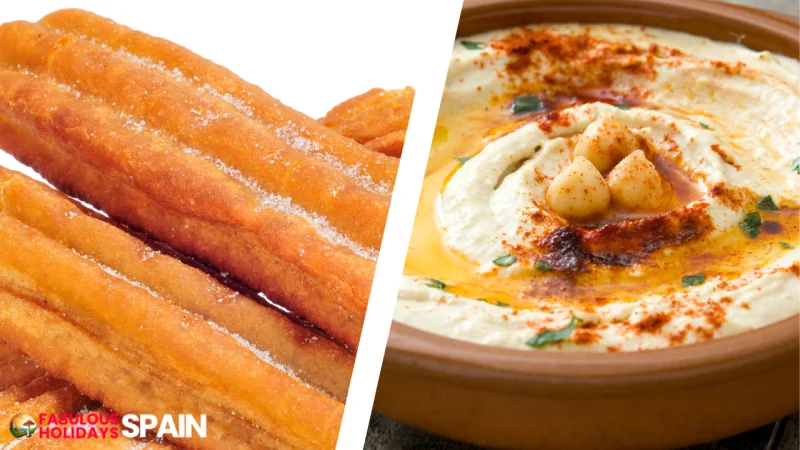
In Spain, real breakfast is called almuerzo. It is the first meal of the day and a leisurely affair. Spaniards enjoy the flavours and connect with people.
Spanish eat almuerzo at home, with families gathered around the table to share stories and catch up on recent events.
This is mostly the case on weekends, though. Mornings and work days are hectic, especially when preparing children for school and themselves for work.
The night is never long enough, no matter which country!
This is why it’s common to have almurezo in cafes and bars, where people can enjoy a quick bite and chat with friends or colleagues.
It is still fascinating that socializing is more important than the meal itself. Spaniards have so much love for life; after 15 years, I am still amazed every time I meet them.
When you visit Spain, please take the opportunity to enjoy almuerzo every day you spend in Spain.
When you leave, you will remember and miss these moments – for life. I know I do.
What Do Spaniards Eat for Almuerzo?
Spanish almuerzo is known for its variety and taste, catering to savoury and sweet preferences.
Here are some of the most popular almuerzo dishes:
- Pan con tomate (Tomato bread): This simple yet delicious classic is a staple of Spanish breakfasts. They tope toasted bread with grated ripened tomato, drizzle with olive oil, and season with salt.
- Tostada (Toast): Toasted bread is a base for different toppings, including jam, butter, cheese, or cured meats like chorizo or jamón serrano.
- Bocadillo (long bread sandwich with curated meat, cheese or egg omelette)
- Huevos revueltos (Scrambled eggs): Scrambled eggs are a popular breakfast option, often served with bread or toast.
- Tortilla española (Spanish omelette): This delicious omelette made with potatoes is an authentic and satisfying breakfast option. Sometimes tortilla will have onions and even chorizo. Extremely delicious!
- Churros con chocolate (Churros with hot chocolate): This heavy combination is a popular breakfast treat.
Regional Almuerzo Variations
While the core elements of a Spanish breakfast remain consistent across the country, there are some regional variations.
In the southern region of Andalusia, croissants and pastries are more popular than pan con tomate.
In the northern region of Asturias, tortos de maíz (cornbread pancakes) are a breakfast staple, while in the Basque Country, kokotxas (cod cheeks) are a popular choice and not found elsewhere in Spain.
Lunch (Comida de Mediodía) Meal Times in Spain
When: Between 2 and 3:30 PM.
Where: Usually at home, in a restaurant, or the workplace.
In Spain, they call lunch comida de mediodía or comida. Comida is a social occasion that brings families, friends, and colleagues together to enjoy delicious food and each other’s company.
Where do They Eat Lunch?
Comida de mediodía, or lunch, is often enjoyed at home, where families gather around the table to share a traditional three-course meal. However, lunch in restaurants, tapas bars, or even outdoors at parks or plazas is also common.
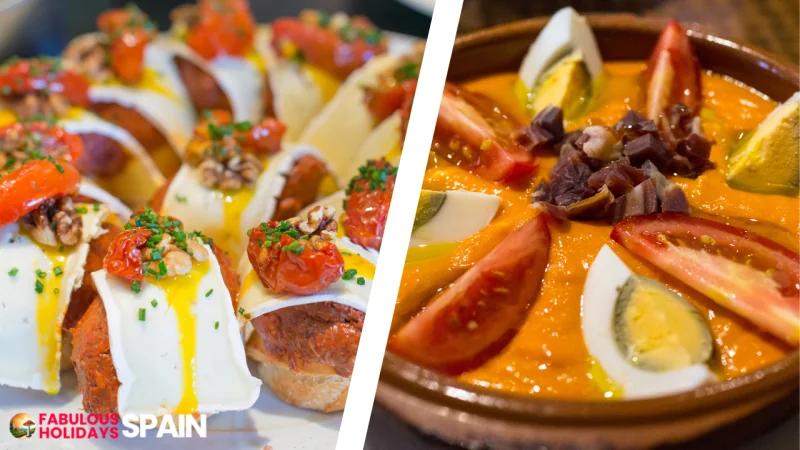
What Do Spaniards Eat for Lunch?
Comida de mediodía is a time to indulge in hearty and flavorful dishes that reflect the rich culinary traditions of Spain. Here are some of the most popular comida dishes:
- Gazpacho (Cold tomato soup): This refreshing soup is a classic Spanish dish with puréed tomatoes, cucumbers, bell peppers, garlic, olive oil, vinegar, and bread. This is more of a tradition in Andalucia and is hot summers.
- Paella (Rice dish with seafood, meat, or vegetables): Paella is a versatile dish that varies across Spain, but it typically features rice, seafood, meat, vegetables, and saffron.
- Croquetas (Breaded and fried croquettes): Croquetas are a popular tapas or snack food that can also be served as a main course. They are typically made with a béchamel sauce and filled with various ingredients, such as ham, cheese, or seafood.
- Tortilla española (Spanish omelette): This savoury omelette made with potatoes, onions, and occasionally chorizo is a hearty and satisfying lunch option.
- Asado (Roasted meat): Asado is a popular dish featuring roasted meats, such as lamb, pork, or chicken. It is often served with grilled or roasted vegetables and aioli sauce.
- Tapas: Tapas are small plates of savoury or sweet bites often shared among diners. They offer a great way to sample a variety of flavours and enjoy the social aspect of Spanish dining.
Regional Lunch Variations (la Comida)
The specific dishes served for comida de mediodía vary depending on the region of Spain. For instance, in Andalusia, seafood paella is a popular choice, while in the Basque Country, grilled meats and pintxos (small skewered appetizers) are prevalent.
In Valencia, fideuá, a noodle-based dish similar to paella, is a local variation.
After lunch, some people sleep in the famous Spanish siesta, but it has declined in the last two decades.
Afternoon Snack (Merienda) Meal Times in Spain
When: Between 5 and 8 PM.
Where: Usually at home, in a restaurant, or the workplace.
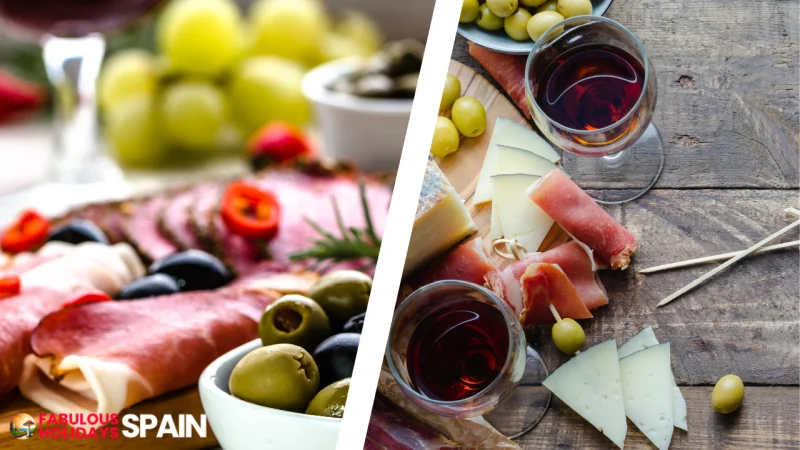
In Spain, merienda is an afternoon snack, typically between 5 and 8 PM. It’s a lighter meal than lunch, but it provides a needed energy boost to tide people over until dinner. Which is late!
Meriendas can be either sweet or savoury, depending on personal preference and the time of year.
Where Do Spanish Eat Merienda?
Meriendas can be enjoyed at home, in cafes, or the park. They’re often social, allowing people to relax and connect with family and friends.
What Do Spaniards Eat for Merienda?
Sweet meriendas are a popular choice, particularly for children. The common sweet merienda options include:
- Churros con chocolate (Churros with hot chocolate): This classic combination is a favourite among Spaniards of all ages.
- Torrijas (Chipped bread soaked in egg batter and fried): Torrijas are a traditional Easter dessert commonly enjoyed as a merienda.
- Barquillos (Thin, crispy wafers): Barquillos are often filled with sweet fillings like chocolate, Nutella, or custard.
- Pastelitos (Small pastries): Pastelitos come in various flavours, from chocolate and almond to fruit and cream.
- Yoghurt with fruit and honey: A healthy and refreshing option, yoghurt with fruit and honey is a popular merienda for adults.
In 2022, the average person in Spain spent €984.51 on food outside of the home.
Source
Savoury meriendas are also widely enjoyed, particularly in the cooler months. Some popular savoury options include:
- Tostas de jamón y queso (Toast with ham and cheese): This simple yet delicious combination is a common merienda choice.
- Gambas al ajillo (Prawns cooked in garlic): Gambas al ajillo are a popular tapas dish and a great option for a merienda.
- Pinchitos morunos (Chorizo skewers): Pinchitos morunos are a savory and satisfying merienda option.
- Empanadas (Stuffed pastries): Empanadas come in various flavours, from savoury meat to sweet fruits.
- Pan con tomate y jamón serrano (Tomato bread with cured ham): A classic Spanish combination, pan con tomate y jamón serrano is a simple yet delicious merienda.
Regional Merienda Variations
As with other meals, merienda options vary regionally. For instance, in Andalusia, montaditos (small open-faced sandwiches) are a popular choice.
In the Basque Country, piperrada (a stew of peppers, onions, and tomatoes) is a common merienda dish. In Galicia, empanadas, often filled with octopus or cheese, are a staple of the merienda menu.
Evening Appetizer (Tapas) Meal Times in Spain
Tapas are small, flavorful dishes typically served in bars and restaurants.
Tapas can be made with various ingredients, including seafood, meat, vegetables, and cheese. They are often served with bread and a glass of wine.
Some of the popular tapas include:
- Croquetas: These are small, crispy croquettes filled with chicken, beef, or fish.
- Gambas al ajillo: This is a garlicky shrimp dish cooked in oil. It is often served with bread for dipping.
- Patatas bravas: This dish of fried potatoes with a spicy tomato sauce.
- Piquillo peppers stuffed with anchovies: This dish features piquillo peppers stuffed with anchovies and garlic. The peppers are often served with a drizzle of olive oil.
- Tortilla de patatas: This is a Spanish omelette made with potatoes, onions, and sometimes chorizo. It is often served hot or cold.
- Tapas are a great way to sample a variety of Spanish flavours. They are also a fun and social way to eat, as they are often shared among friends and family.
And finally, the dinner.
Dinner (La Cena) Meal Times in Spain
When: 8 – 11 PM.
Where: Usually at home on weekdays, on weekends at home or in a restaurant.
In Spain, dinner, known as la cena, is traditionally a light meal. It’s a time for socializing with family or friends over a leisurely meal.
Where Does La Cena Happen?
La cena is typically enjoyed on weekdays at home, with families coming together to catch up on the day’s events and enjoy each other’s company.
At the end of the week Spanish love to have dinner at restaurants or tapas bars, where they meet with friends or extended family.
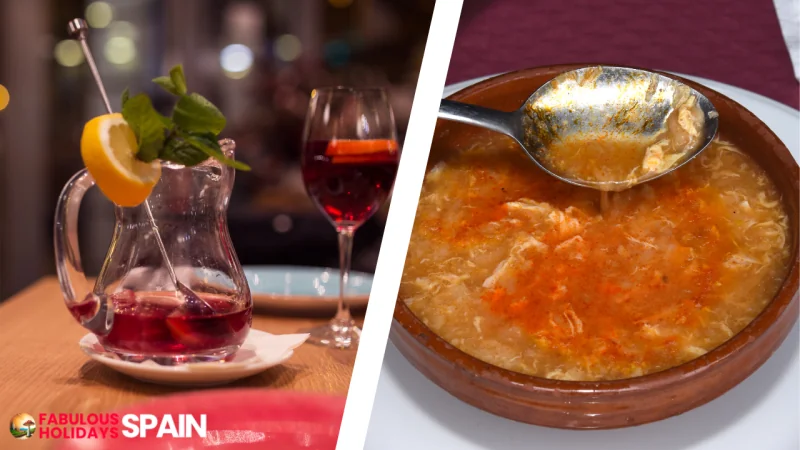
What Do Spaniards Eat for La Cena?
La cena is known for its simplicity and focus on fresh, seasonal ingredients. Here are some of the most popular dinner dishes:
- Paella: This iconic Valencian dish features rice cooked with various seafood, vegetables, and sometimes meat or poultry.
- Gazpacho: This chilled tomato soup is a refreshing and light option for a warm evening.
- Pisto manchego: This vegetable stew is a staple of the Castilla-La Mancha region and features eggplant, peppers, and zucchini.
- Ensalada de tomate (Tomato salad): This simple salad featuring ripe tomatoes, olive oil, salt, and pepper is a refreshing and healthy choice for dinner.
- Pescado (fish on a grill with potatoes or rice)
Regional Dinner (la Cena) Variations
As with other meals, there are regional variations in what Spaniards eat for dinner. For instance, seafood is more prominent in the coastal regions, while stews and hearty dishes are more common in the inland regions.
La Cena Meal Time is All About Connection
La cena is not just about fueling the body; it’s a social occasion that fosters a sense of connection and community.
The leisurely pace of Spanish dinners allows for conversation, laughter, and sharing stories. It’s a time to unwind after a long day and enjoy the company of loved ones.
So, if you’re ever in Spain, be sure to experience the unique delights of a Spanish dinner. It’s a delightful way to end the day and immerse yourself in the rich culture of this culinary paradise.
Now it’s your turn
This is all you’ll need to navigate meal times in Spain. You know the most popular (and delicious) food to order and when.
It’s time to book your airline tickets and hotel and experience all Spain has to offer your taste buds.
I wish you a pleasant and tasty stay!
Buen viaje!
Q: What are the mealtimes in Spain?
A: Spain has a unique rhythm compared to other countries. Breakfast is light; lunch is the main event (often called “la comida” – the meal), followed by a mid-afternoon snack, tapas or an aperitif, and then a late dinner.
Q: What time are meals served in Spain?
A: Breakfast is around 7-9 am or 10-11 am. Lunch reigns supreme from 2-3:30 pm, with dinner being a social affair from 9:30-10:30 pm.
Q: What time do people go to bed in Spain?
A: With late dinners, Spaniards tend to hit the hay later, usually around midnight or even 1 am.
Q: What is the biggest meal of the day in Spain?
A: Lunch, or “la comida,” is the show’s star. It’s a multi-course affair with a long, leisurely pace.
Q: Why do Spaniards eat so late?
Q: Which meal do most Spaniards skip?
A: Breakfast tends to be the lightest and is sometimes skipped, especially on weekdays.
Q: What are the rules for eating in Spain?
A: Embrace the slower pace! Lunch is a time to relax and enjoy the company. Don’t be afraid to share plates with friends during tapas or dinner. People often share food.
Q: What is Spain’s national drink?
A: Wine is popular throughout meals, but Spain also likes Sangria, a refreshing fruit punch with wine.
Q: What time is breakfast in Spain?
A: Unlike some countries, Spain offers a double breakfast option! You can grab a coffee and pastry early or have a more substantial breakfast later.
Q: What time are evening meals typically served in Spain? Why?
A: Dinner starts late, around 9:30-10:30 pm. This could be due to the extended lunch break and a cultural preference for socializing.
Q: What makes lunch in Spain different from most countries?
A: Lunch in Spain is a multi-course affair, often with an appetizer, main course, dessert, and coffee, all enjoyed relaxed. It’s more than just fueling up; it’s a social event.
Q: How to eat in Spain?
A: Follow the locals’ lead! Take your time, enjoy conversation, and don’t be afraid to share plates with friends during tapas or dinner.
Q: What are the 10 most common foods consumed in Spain?
A: While the list is long, some staples include: jamón (cured ham), tortilla española (potato omelette), paella (rice dish), gazpacho (cold tomato soup), churros (fried dough), pulpo a la gallega (Galician octopus), and an endless variety of tapas.
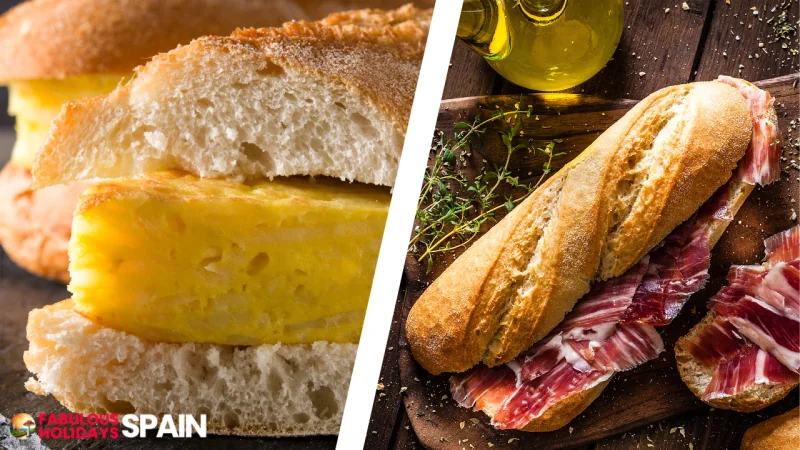

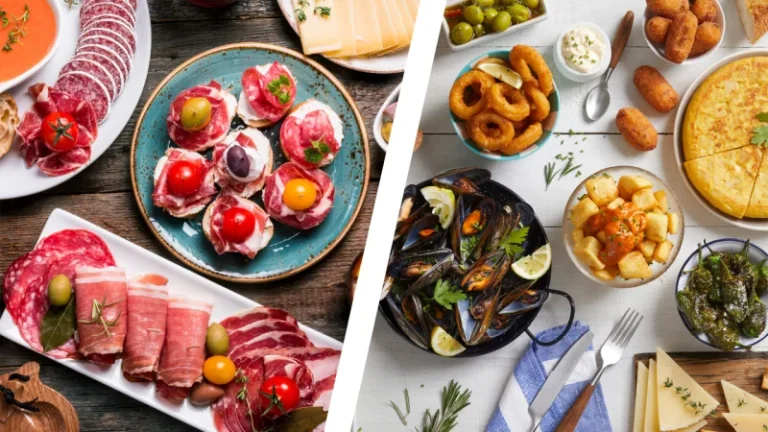



Great article, helpful too, loved reading about your personal experience.